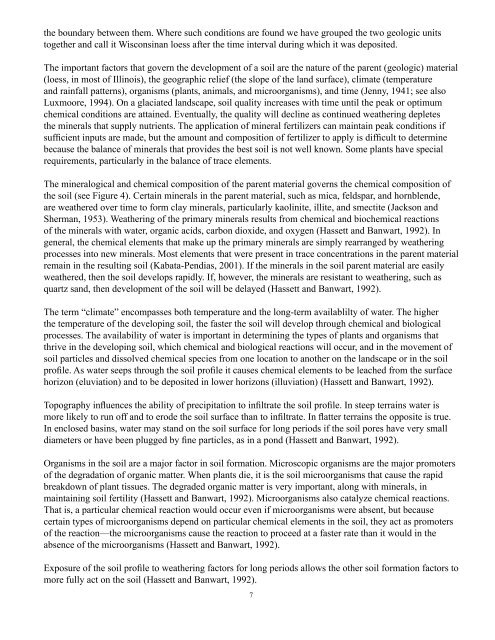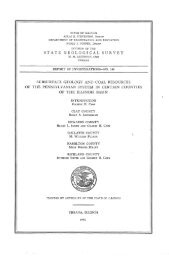(Imbrie and Imbrie, 1979), we believe th<strong>at</strong> the age <strong>of</strong> the Illinoian can be now constrained to the periodfrom 180,000 to 125,000 years ago. Previous estim<strong>at</strong>es placed the older boundary back to 300,000 yearsago, but we believe this age should be rejected because no glacial sediments in this age range have beenfound in the Midwest (Follmer, 1996).In southern <strong>Illinois</strong> near the Mississippi River a fourth loess has been found and was correl<strong>at</strong>ed withthe Crowley’s Ridge loess <strong>of</strong> Arkansas. Probable correl<strong>at</strong>ions are known in <strong>Illinois</strong> and up the MissouriRiver valley to Nebraska. Up to two older loesses have been observed in <strong>Illinois</strong> and in exposures alongthe Missouri River near St. Charles, Missouri. All across the glaci<strong>at</strong>ed part <strong>of</strong> <strong>Illinois</strong>, silt units th<strong>at</strong> maybe loess have been observed in the older parts <strong>of</strong> the glacial sequence. These silt units have mostly beenobserved in areas <strong>of</strong> thick drift where preglacial valleys have been filled with glacial deposits. At thistime, we do not know much about these deposits. The oldest glacial deposits in <strong>Illinois</strong> are approxim<strong>at</strong>ely800,000 years old (Follmer, 1996).The loess units are distinguished from each other <strong>by</strong> physical and mineralogical properties. The mostimportant such distinguishing characteristics are those caused <strong>by</strong> soil form<strong>at</strong>ion. In geologic terms, thesoil <strong>at</strong> the land surface, which has developed mostly in the Peoria loess, is called the modern soil. Soilpr<strong>of</strong>iles, developed in the tops <strong>of</strong> buried loess units are called paleosols, which means ancient, or fossilsoils. The fossil soils’ characteristics indic<strong>at</strong>e th<strong>at</strong> the unit was once <strong>at</strong> the ground surface and exposed toactive soil form<strong>at</strong>ion. Some other buried glacial deposits also have a paleosol, developed in their upperpart; th<strong>at</strong> is, there are soil fe<strong>at</strong>ures in the upper parts <strong>of</strong> some important geologic units. These buried soilsare important markers for mapping the distribution <strong>of</strong> important units. The classific<strong>at</strong>ion <strong>of</strong> the majorQu<strong>at</strong>ernary geologic units is based on these key markers (Follmer, 1982)The Qu<strong>at</strong>ernary deposits map <strong>of</strong> <strong>Illinois</strong> (Figure 3) shows the distribution <strong>of</strong> the major Qu<strong>at</strong>ernary units(Hansel and Johnson, 1996) as they would appear if they were not buried <strong>by</strong> loess deposits. The deposits<strong>of</strong> the last glaci<strong>at</strong>ion are named after Wisconsin. In <strong>Illinois</strong> the deposits <strong>of</strong> this most recent glaci<strong>at</strong>ion aremostly limited to the NE quarter <strong>of</strong> the St<strong>at</strong>e. The next older glaci<strong>at</strong>ion is named after <strong>Illinois</strong> becauseits deposits cover most <strong>of</strong> the St<strong>at</strong>e. Deposits from some older glaci<strong>at</strong>ions have been found in sc<strong>at</strong>teredplaces in <strong>Illinois</strong>, especially in the lowermost deposits in buried bedrock valleys, but the evidence <strong>of</strong> theirstr<strong>at</strong>igraphic succession and age is limited. Until definitive work is done on these older units, they aremeanwhile grouped into an indefinite time period called pre-Illinoian (Lineback et al., 1979).Where it has not been eroded, the Peoria loess is the parent m<strong>at</strong>erial <strong>of</strong> the modern soil across most <strong>of</strong>the nearly fl<strong>at</strong> uplands <strong>of</strong> <strong>Illinois</strong>. In valleys, the upper part <strong>of</strong> the alluvium is mostly derived from loesseroded from the surrounding hills in the w<strong>at</strong>ershed. Where the Peoria loess is missing, particularly onsloping land where it has been stripped <strong>of</strong>f <strong>by</strong> erosion, the older loesses are almost always missing also.At such sites the soils are formed in other glacial deposits or bedrock.The important vari<strong>at</strong>ions in the physical characteristics <strong>of</strong> modern soils from place to place are given soilnames <strong>by</strong> the USDA-NRCS Soil Survey. We use these names in combin<strong>at</strong>ion with the geologic names <strong>of</strong>the parent m<strong>at</strong>erials assigned <strong>by</strong> the ISGS when describing the soil cores we collect. In places where thethickness <strong>of</strong> the Peoria loess is less than the solum thickness, i.e., where the soil horizons have developedinto the underlying geologic unit, the soil pr<strong>of</strong>ile is described as having formed in two m<strong>at</strong>erials and, insome places, three. In southern <strong>Illinois</strong>, the Peoria loess across much <strong>of</strong> the fl<strong>at</strong> upland on the Illinoiantill plain is less than five feet thick and underlain <strong>by</strong> the Roxana loess. In these situ<strong>at</strong>ions the modern soilfe<strong>at</strong>ures (roots, and so forth) commonly extend <strong>through</strong> the Peoria and into the Roxana, thus blurring6
the boundary between them. Where such conditions are found we have grouped the two geologic unitstogether and call it Wisconsinan loess after the time interval during which it was deposited.The important factors th<strong>at</strong> govern the development <strong>of</strong> a soil are the n<strong>at</strong>ure <strong>of</strong> the parent (geologic) m<strong>at</strong>erial(loess, in most <strong>of</strong> <strong>Illinois</strong>), the geographic relief (the slope <strong>of</strong> the land surface), clim<strong>at</strong>e (temper<strong>at</strong>ureand rainfall p<strong>at</strong>terns), organisms (plants, animals, and microorganisms), and time (Jenny, 1941; see alsoLuxmoore, 1994). On a glaci<strong>at</strong>ed landscape, soil quality increases with time until the peak or optimumchemical conditions are <strong>at</strong>tained. Eventually, the quality will decline as continued we<strong>at</strong>hering depletesthe minerals th<strong>at</strong> supply nutrients. The applic<strong>at</strong>ion <strong>of</strong> mineral fertilizers can maintain peak conditions ifsufficient inputs are made, but the amount and composition <strong>of</strong> fertilizer to apply is difficult to determinebecause the balance <strong>of</strong> minerals th<strong>at</strong> provides the best soil is not well known. Some plants have specialrequirements, particularly in the balance <strong>of</strong> trace elements.The mineralogical and chemical composition <strong>of</strong> the parent m<strong>at</strong>erial governs the chemical composition <strong>of</strong>the soil (see Figure 4). Certain minerals in the parent m<strong>at</strong>erial, such as mica, feldspar, and hornblende,are we<strong>at</strong>hered over time to form clay minerals, particularly kaolinite, illite, and smectite (Jackson andSherman, 1953). We<strong>at</strong>hering <strong>of</strong> the primary minerals results from chemical and biochemical reactions<strong>of</strong> the minerals with w<strong>at</strong>er, organic acids, carbon dioxide, and oxygen (Hassett and Banwart, 1992). Ingeneral, the chemical elements th<strong>at</strong> make up the primary minerals are simply rearranged <strong>by</strong> we<strong>at</strong>heringprocesses into new minerals. Most elements th<strong>at</strong> were present in trace concentr<strong>at</strong>ions in the parent m<strong>at</strong>erialremain in the resulting soil (Kab<strong>at</strong>a-Pendias, 2001). If the minerals in the soil parent m<strong>at</strong>erial are easilywe<strong>at</strong>hered, then the soil develops rapidly. If, however, the minerals are resistant to we<strong>at</strong>hering, such asquartz sand, then development <strong>of</strong> the soil will be delayed (Hassett and Banwart, 1992).The term “clim<strong>at</strong>e” encompasses both temper<strong>at</strong>ure and the long-term availablilty <strong>of</strong> w<strong>at</strong>er. The higherthe temper<strong>at</strong>ure <strong>of</strong> the developing soil, the faster the soil will develop <strong>through</strong> chemical and biologicalprocesses. The availability <strong>of</strong> w<strong>at</strong>er is important in determining the types <strong>of</strong> plants and organisms th<strong>at</strong>thrive in the developing soil, which chemical and biological reactions will occur, and in the movement <strong>of</strong>soil particles and dissolved chemical species from one loc<strong>at</strong>ion to another on the landscape or in the soilpr<strong>of</strong>ile. As w<strong>at</strong>er seeps <strong>through</strong> the soil pr<strong>of</strong>ile it causes chemical elements to be leached from the surfacehorizon (eluvi<strong>at</strong>ion) and to be deposited in lower horizons (illuvi<strong>at</strong>ion) (Hassett and Banwart, 1992).Topography influences the ability <strong>of</strong> precipit<strong>at</strong>ion to infiltr<strong>at</strong>e the soil pr<strong>of</strong>ile. In steep terrains w<strong>at</strong>er ismore likely to run <strong>of</strong>f and to erode the soil surface than to infiltr<strong>at</strong>e. In fl<strong>at</strong>ter terrains the opposite is true.In enclosed basins, w<strong>at</strong>er may stand on the soil surface for long periods if the soil pores have very smalldiameters or have been plugged <strong>by</strong> fine particles, as in a pond (Hassett and Banwart, 1992).Organisms in the soil are a major factor in soil form<strong>at</strong>ion. Microscopic organisms are the major promoters<strong>of</strong> the degrad<strong>at</strong>ion <strong>of</strong> organic m<strong>at</strong>ter. When plants die, it is the soil microorganisms th<strong>at</strong> cause the rapidbreakdown <strong>of</strong> plant tissues. The degraded organic m<strong>at</strong>ter is very important, along with minerals, inmaintaining soil fertility (Hassett and Banwart, 1992). Microorganisms also c<strong>at</strong>alyze chemical reactions.Th<strong>at</strong> is, a particular chemical reaction would occur even if microorganisms were absent, but becausecertain types <strong>of</strong> microorganisms depend on particular chemical elements in the soil, they act as promoters<strong>of</strong> the reaction—the microorganisms cause the reaction to proceed <strong>at</strong> a faster r<strong>at</strong>e than it would in theabsence <strong>of</strong> the microorganisms (Hassett and Banwart, 1992).Exposure <strong>of</strong> the soil pr<strong>of</strong>ile to we<strong>at</strong>hering factors for long periods allows the other soil form<strong>at</strong>ion factors tomore fully act on the soil (Hassett and Banwart, 1992).7
- Page 1 and 2: A Progress Report on the Descriptio
- Page 3 and 4: INTRODUCTIONThe Illinois State Geol
- Page 5 and 6: As continental glaciers advanced in
- Page 7: In areas where the glacial sediment
- Page 11 and 12: Occlusion refers to the physical en
- Page 13 and 14: tungsten carbide grinding capsule t
- Page 15 and 16: RESULTS AND DISCUSSIONSampling Plan
- Page 17 and 18: increases also. If the correlation
- Page 19 and 20: CO 2 gas= CO 2 aqCO 2 aq+ H 2O = H
- Page 21 and 22: Potassium Typically, potassium occu
- Page 23 and 24: on oxides and hydroxides. Fertilize
- Page 25 and 26: For most cores, the Rb content was
- Page 27 and 28: Brady, N. C. and R. R. Weil, 1999,
- Page 29 and 30: Killey, M. M., 1998, Illinois’ Ic
- Page 31 and 32: Table 1. Core number, county name,
- Page 33 and 34: Table 3. Texture of samples from co
- Page 35 and 36: Table 9. Texture of samples from co
- Page 37 and 38: Table 15. Texture of samples from c
- Page 39 and 40: Table 19. Soil texture, soil type,
- Page 41 and 42: Table 20 continued. Correlation coe
- Page 43 and 44: Table 21. Elemental composition of
- Page 45 and 46: Table 23. Elemental composition of
- Page 47 and 48: Table 25. Elemental composition of
- Page 49 and 50: Table 27. Elemental composition of
- Page 51 and 52: Table 29. Elemental composition of
- Page 53 and 54: Table 31. Elemental composition of
- Page 55 and 56: Table 33. Elemental composition of
- Page 57 and 58: Table 35. Elemental composition of
- Page 59 and 60:
Table 37. Means and ranges of eleme
- Page 61 and 62:
Sample locationFigure 2 Sample loca
- Page 63 and 64:
Figure 461
- Page 65 and 66:
Figure 6.63
- Page 67 and 68:
Figure 8.65
- Page 69 and 70:
Figure 10.67
- Page 71 and 72:
Figure 12.69
- Page 73 and 74:
Figure 14.71
- Page 75 and 76:
Figure 16.73
- Page 77 and 78:
Figure 18.75
- Page 79 and 80:
Figure 20.77
- Page 81 and 82:
Figure 22.79
- Page 83 and 84:
Figure 24.81
- Page 85 and 86:
Figure 26.83
- Page 87 and 88:
Figure 28.85
- Page 89 and 90:
Figure 31.87
- Page 91 and 92:
Figure 33.89
- Page 93 and 94:
Figure 35.91
- Page 95:
Figure 37.93
















